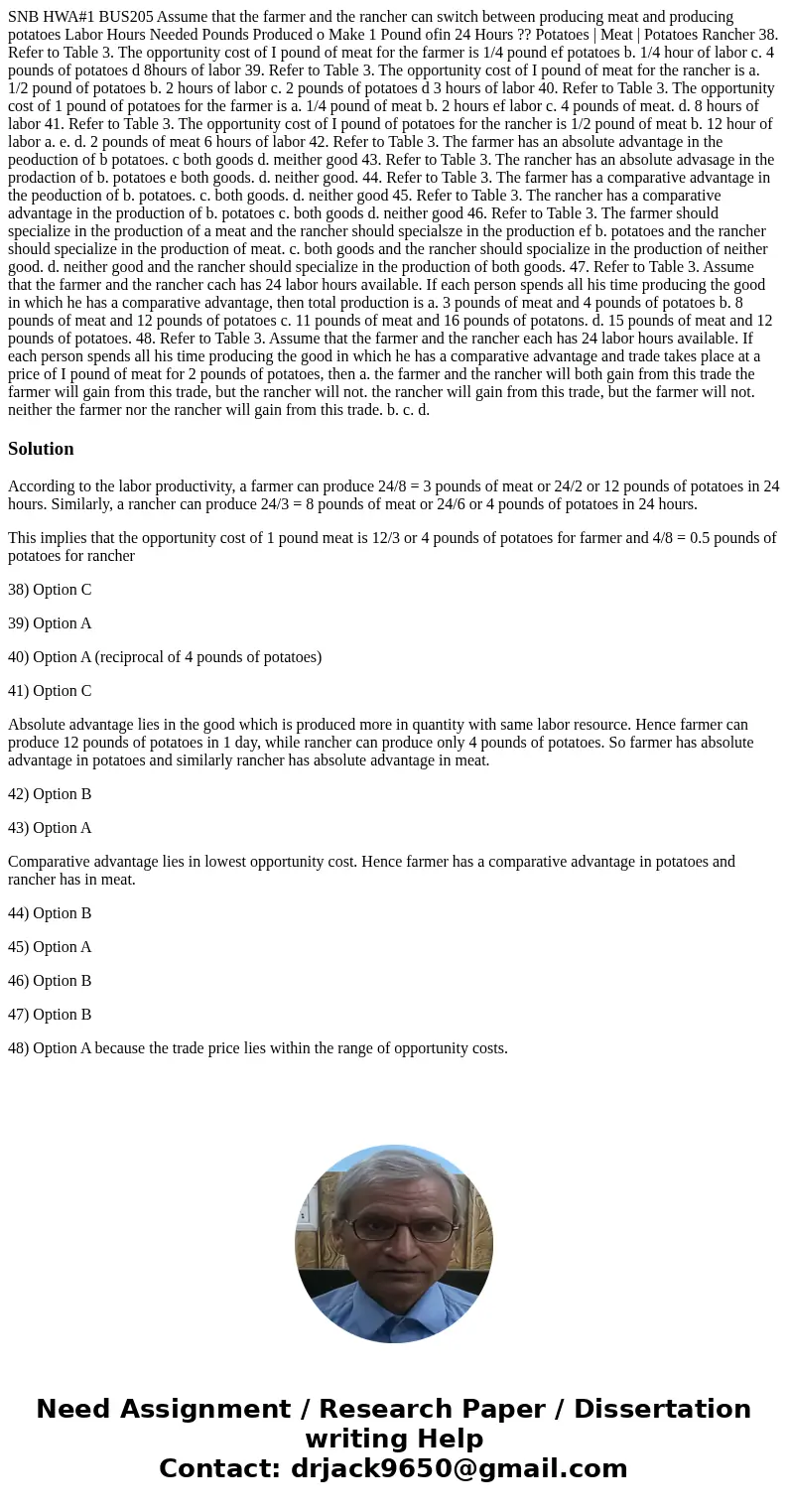SNB HWA#1 BUS205 Assume that the farmer and the rancher can switch between producing meat and producing potatoes Labor Hours Needed Pounds Produced o Make 1 Pound ofin 24 Hours ?? Potatoes | Meat | Potatoes Rancher 38. Refer to Table 3. The opportunity cost of I pound of meat for the farmer is 1/4 pound ef potatoes b. 1/4 hour of labor c. 4 pounds of potatoes d 8hours of labor 39. Refer to Table 3. The opportunity cost of I pound of meat for the rancher is a. 1/2 pound of potatoes b. 2 hours of labor c. 2 pounds of potatoes d 3 hours of labor 40. Refer to Table 3. The opportunity cost of 1 pound of potatoes for the farmer is a. 1/4 pound of meat b. 2 hours ef labor c. 4 pounds of meat. d. 8 hours of labor 41. Refer to Table 3. The opportunity cost of I pound of potatoes for the rancher is 1/2 pound of meat b. 12 hour of labor a. e. d. 2 pounds of meat 6 hours of labor 42. Refer to Table 3. The farmer has an absolute advantage in the peoduction of b potatoes. c both goods d. meither good 43. Refer to Table 3. The rancher has an absolute advasage in the prodaction of b. potatoes e both goods. d. neither good. 44. Refer to Table 3. The farmer has a comparative advantage in the peoduction of b. potatoes. c. both goods. d. neither good 45. Refer to Table 3. The rancher has a comparative advantage in the production of b. potatoes c. both goods d. neither good 46. Refer to Table 3. The farmer should specialize in the production of a meat and the rancher should specialsze in the production ef b. potatoes and the rancher should specialize in the production of meat. c. both goods and the rancher should spocialize in the production of neither good. d. neither good and the rancher should specialize in the production of both goods. 47. Refer to Table 3. Assume that the farmer and the rancher cach has 24 labor hours available. If each person spends all his time producing the good in which he has a comparative advantage, then total production is a. 3 pounds of meat and 4 pounds of potatoes b. 8 pounds of meat and 12 pounds of potatoes c. 11 pounds of meat and 16 pounds of potatons. d. 15 pounds of meat and 12 pounds of potatoes. 48. Refer to Table 3. Assume that the farmer and the rancher each has 24 labor hours available. If each person spends all his time producing the good in which he has a comparative advantage and trade takes place at a price of I pound of meat for 2 pounds of potatoes, then a. the farmer and the rancher will both gain from this trade the farmer will gain from this trade, but the rancher will not. the rancher will gain from this trade, but the farmer will not. neither the farmer nor the rancher will gain from this trade. b. c. d.
According to the labor productivity, a farmer can produce 24/8 = 3 pounds of meat or 24/2 or 12 pounds of potatoes in 24 hours. Similarly, a rancher can produce 24/3 = 8 pounds of meat or 24/6 or 4 pounds of potatoes in 24 hours.
This implies that the opportunity cost of 1 pound meat is 12/3 or 4 pounds of potatoes for farmer and 4/8 = 0.5 pounds of potatoes for rancher
38) Option C
39) Option A
40) Option A (reciprocal of 4 pounds of potatoes)
41) Option C
Absolute advantage lies in the good which is produced more in quantity with same labor resource. Hence farmer can produce 12 pounds of potatoes in 1 day, while rancher can produce only 4 pounds of potatoes. So farmer has absolute advantage in potatoes and similarly rancher has absolute advantage in meat.
42) Option B
43) Option A
Comparative advantage lies in lowest opportunity cost. Hence farmer has a comparative advantage in potatoes and rancher has in meat.
44) Option B
45) Option A
46) Option B
47) Option B
48) Option A because the trade price lies within the range of opportunity costs.

 Homework Sourse
Homework Sourse